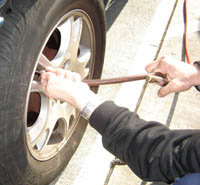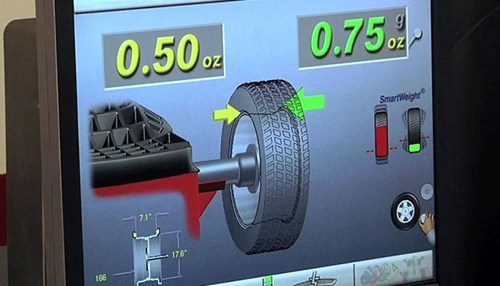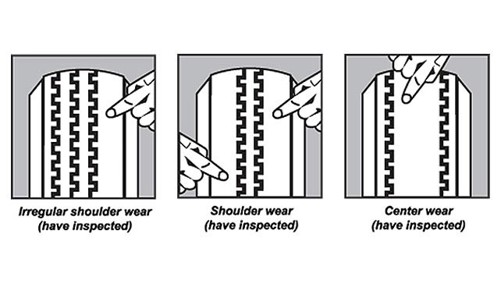
Driving on any tire that does not have the correct inflation pressure is dangerous. Recent research by the National Highway Traffic Safety Administration (NHTSA) indicates about 30% of cars and light trucks have at least one tire under-inflated by 8 psi or more (DOT HS 809 317). Under-inflated tires and overloaded vehicles are the leading cause of tire failure. It is extremely difficult to tell just by looking at your tires if they are properly inflated. Purchase an accurate tire gauge and check your tire pressures at least once a month along with their overall condition. Proper inflation pressure for your tires may be found in the vehicle owner's manual or the vehicle's tire information placard. If you have changed your tire size, ask the tire dealer for the new recommended inflation pressure. Never exceed the maximum pressure indicated on the tire sidewall. Making sure that your vehicle is operating with properly inflated tires will make you safer on the highways and increase fuel savings.
You will find the original equipment (OE) recommended pressure on a placard or sticker in the driver's side door jam, glove compartment or near the gas cap. If your vehicle does not have a placard, check the owner's manual or consult the vehicle manufacturer, tire manufacturer, or your local tire dealer. The tire placard tells you the maximum vehicle load, the cold tire pressure, and the tire size recommended by the vehicle manufacturer. Air pressures may be different for front and rear tires. If your vehicle no longer is equipped with the OE size tires, consult your Toyo dealer for proper inflation information.

Check inflation pressure, including the spare, at least once a month and before every long road trip. Tires should be checked when they are cold (before they have run a mile). Otherwise, your tires will have heated up, increasing the air pressure inside them by several pounds. If you must drive over a mile for air, record each tire's pressure before you start. At the station, measure each tire's inflation again and if the pressure has increased, adjust the amount of additional air pressure needed. For example, if cold pressure should be 35PSI, but cold pressure was 28PSI, and current pressure is 33PSI, you should inflate the warm tires to 40PSI. Never "bleed" or reduce the air pressure in a hot tire. Failure to maintain correct inflation pressures may result in rapid wear and uneven tread wear, improper vehicle handling and excessive heat buildup, which may result in tire failure.

Tires naturally lose pressure through the process of permeation or, air passing through the pores of the tire. Changes in outdoor temperature can affect the rate at which tires lose air. This change is more pronounced in hot weather. Generally speaking, a tire will lose one or two pounds of air pressure per month in cool weather and even more in hot weather. Remember, under-inflation is the leading cause of tire failure, so check inflation pressure regularly.
Many late-model vehicles are equipped with temporary spare tires and wheels that are different from your regular tires and wheels. It is important to realize that these spares have far more limitations than a typical tire, including speed and recommended driving distance. Some may require higher inflation pressure, or the use of special canisters to inflate the tire. You should familiarize yourself with the spare by reading the owner's manual and the sidewall of the spare. And remember to check the air pressure of your spare frequently.
The purpose of regularly rotating tires is to achieve more uniform wear for all tires on a vehicle. Rotation is important because each tire on a car carries a different amount of weight, making them wear at different rates. By rotating them, you basically even out those differences. Follow your vehicle owner's manual for the appropriate rotation pattern for your vehicle.
Our Limited Warranty recommends rotating your Toyo tires every 3,500 miles or less for high performance (low profile) tires and every 7,500 miles or less for standard passenger and light truck tires. More frequent rotation or a thorough vehicle inspection may be necessary if upon inspection you see signs of uneven wear. If your tires show uneven wear, ask your Toyo Tires dealer to check and correct any misalignment, imbalance or other mechanical problem before rotating the tires. After rotation, adjust individual tire air pressures. See the proper inflation section for details.
The following are popular rotation patterns. However, some tires cannot be rotated according to popular patterns. Such tires include uni-directional tires with asymmetric tread designs. Also, some vehicles may have different sized tires mounted on the front and rear axles, and these different sized tires may also have rotation restrictions. Check your owner's manual or visit your Toyo Tires dealer for recommendations for these special cases.

Everyday driving can affect the balance of your tires. Toyo Tires explains how your tires can come out of balance and how routine inspections for tire rotation and balance can extend the life of your tires and increase your driving enjoyment.
You may have noticed small metallic weights placed on the rim of your tire. These weights help the tire and wheel assembly remain balanced at all speeds. At high speeds a tire that is not balanced properly can generate severe vibrations. An unbalanced tire and wheel can also lead to irregular treadwear and shorten the life of your tire. Quality-made tires with higher uniformity require fewer wheel weights.
Some expensive alloy wheels can be damaged with the use of standard lead weights and may require the use of a coated weight. See your Toyo Tires dealer for more information.

Proper wheel alignment can help extend tire life. Toyo Tires helps you identify if your vehicle is out of alignment, explains what the alignment process includes, and defines common alignment settings such as positive and negative camber and toe-in and toe-out.
Misalignment of wheels in the front or rear, improperly operating brakes or shock absorbers, bent wheels, worn bushings, and any other mechanical problems can cause uneven and rapid treadwear. Each of these situations should be corrected immediately by a tire dealer. Front-wheel-drive vehicles, and those with independent rear suspension, require alignment of all four wheels. Have your alignment checked periodically as specified by the vehicle owner's manual or whenever you have an indication of trouble such as pulling or vibration in the steering wheel. It is also important to note that front-wheel-drive vehicles and those with independent rear suspensions require special attention, and alignment should be checked periodically. A bad jolt - such as hitting a pothole - can throw your vehicle out of alignment. Such an impact can also bend the rim, causing a loss of air pressure and damage to your tires with little or no visible evidence present. If this happens, see your Toyo Tires dealer for a tire inspection.
At least once a month, inspect your tires closely for signs of tire damage such as cuts or punctures as well as uneven or excessive wear. Uneven wear patterns may be caused by improper inflation pressures, misalignment, improper balance, or suspension neglect. If not corrected, further tire damage will occur. If you discover uneven wear, bring your car to your nearest Toyo Tires dealer. In many instances, the dealer can correct the problem so you can continue to use your tire.

When the tread is worn down to one-sixteenth of an inch, the tire is worn out and it is time to replace it. Built-in tread wear indicators, or "wear bars," which look like narrow strips of smooth rubber across the tread, will appear on the tire when that point of wear is reached.
Other Things to Look For:
Which types of tire damage are serviceable? The answer to that question depends upon the injury itself. Every injury, including punctures, scrapes, bulges, separations, or cuts should be evaluated by your Toyo Tires dealer. Often, small punctures isolated to the tread of the tire can be repaired by a professional. It is important that the tire is repaired using the Rubber Manufacturer Association's guidelines for permanent repair.
Ignoring a damaged tire and continuing to drive on it can turn an inexpensive fix into an expensive problem. Damaged tires lose air, causing their operating temperature to rise, which can cause some components to separate, or damage the tire body in ways that ruin it.
You can never play it too safe; if your tire shows visible damage or you suspect hidden damage due to small punctures or impact, consult your Toyo Tires dealer.
Tires should be replaced when the tread is worn down to 2/32nds, or one-sixteenth of an inch. Checking the tread depth of your tires costs just a penny! Take a penny and insert it into the tread with President Lincoln's head down. If you can see the top of his head your tires are at or below 2/32nds. If a portion of his head is covered, you have more than 2/32nds. Built-in treadwear indicators, or "wear bars," which look like narrow strips of smooth rubber across the tread, will also appear on the tire when that point of wear is reached. Tires may need to be replaced sooner, if there is excessive uneven wear, meaning one area of the tread is significantly more worn down than other areas. This uneven wear can cause further damage. If you have questions or are uncertain about the tread depth remaining on your tires, take your vehicle to a tire dealer for inspection.